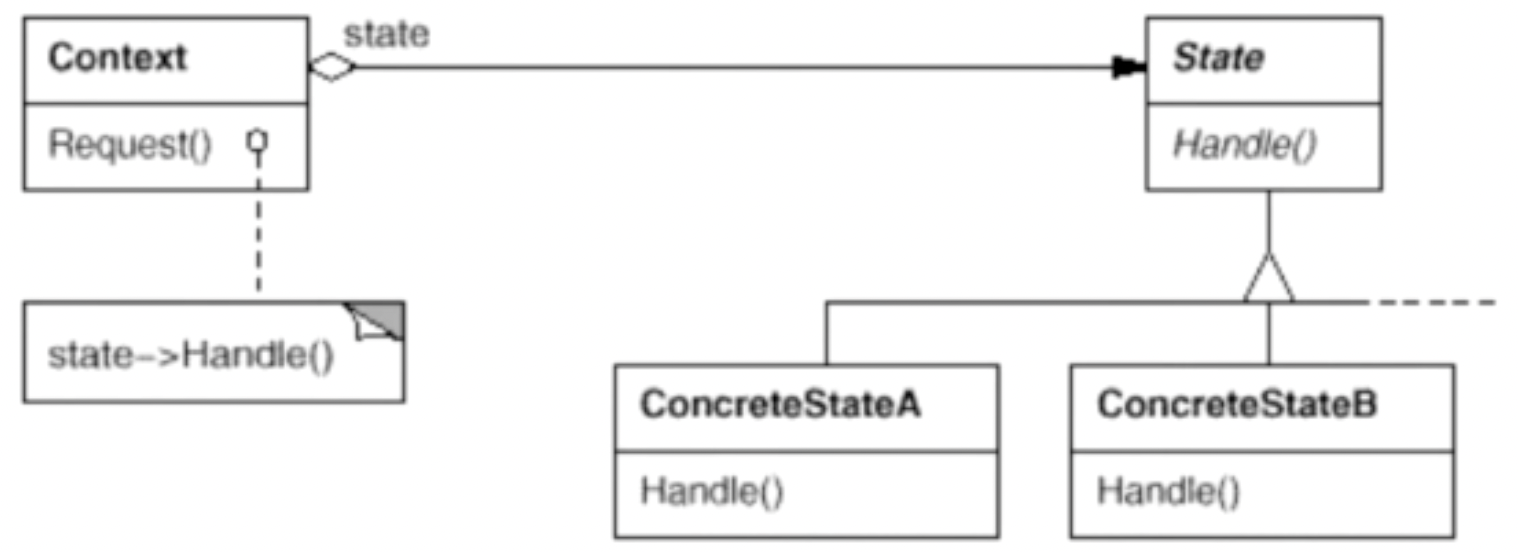状态模式
状态模式允许一个对象在其内部状态改变时改变它的行为,对象看起来似乎修改了它的类。其别名为状态对象。
示意图

示例代码
ts
abstract class NetworkState {
nextState?: NetworkState;
abstract operation1(): void;
abstract operation2(): void;
abstract operation3(): void;
// ...
}
class OpenState extends NetworkState {
private static instance?: NetworkState;
static getInstance() {
if (!this.instance) {
this.instance = new this();
}
return this.instance;
}
operation1() {
// do something
this.nextState = CloseState.getInstance();
}
operation2() {
// do something
this.nextState = ConnectedState.getInstance();
}
operation3() {
// do something
this.nextState = OpenState.getInstance();
}
}
class CloseState extends NetworkState {
/* ... */
}
class ConnectedState extends NetworkState {
/* ... */
}
class NetworkProcessor {
private state: NetworkState;
constructor(state: NetworkState) {
this.state = state;
}
operation1() {
// do something
this.state.operation1();
this.state = this.state.nextState;
// do something
}
operation2() {
// do something
this.state.operation2();
this.state = this.state.nextState;
// do something
}
operation3() {
// do something
this.state.operation3();
this.state = this.state.nextState;
// do something
}
}abstract class NetworkState {
nextState?: NetworkState;
abstract operation1(): void;
abstract operation2(): void;
abstract operation3(): void;
// ...
}
class OpenState extends NetworkState {
private static instance?: NetworkState;
static getInstance() {
if (!this.instance) {
this.instance = new this();
}
return this.instance;
}
operation1() {
// do something
this.nextState = CloseState.getInstance();
}
operation2() {
// do something
this.nextState = ConnectedState.getInstance();
}
operation3() {
// do something
this.nextState = OpenState.getInstance();
}
}
class CloseState extends NetworkState {
/* ... */
}
class ConnectedState extends NetworkState {
/* ... */
}
class NetworkProcessor {
private state: NetworkState;
constructor(state: NetworkState) {
this.state = state;
}
operation1() {
// do something
this.state.operation1();
this.state = this.state.nextState;
// do something
}
operation2() {
// do something
this.state.operation2();
this.state = this.state.nextState;
// do something
}
operation3() {
// do something
this.state.operation3();
this.state = this.state.nextState;
// do something
}
}优缺点
优点
- 将特定状态的相关行为局部化,并且将不同状态的行为分割开来;
- 允许对象在运行时根据状态改变它的行为。
缺点
- 状态模式的使用必然会增加系统的类与对象的个数;
- 状态的切换要执行许多操作,而且各个状态的行为相差不大时会带来许多相似类的膨胀问题;
- 状态模式的结构与实现都较为复杂,如果使用不当会导致程序结构和代码的混乱。
使用场景
在软件构建过程中,某些对象的状态如果改变,其行为也会随之而发生变化,比如文档处于只读状态,其支持的行为和读写状态支持的行为就可能完全不同。
如何在运行时根据对象的状态来透明地更改对象的行为?而不会为对象操作和状态转化之间引入紧耦合?